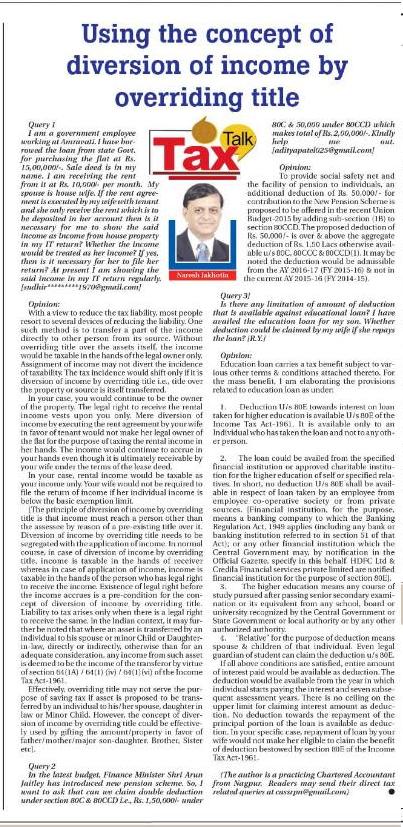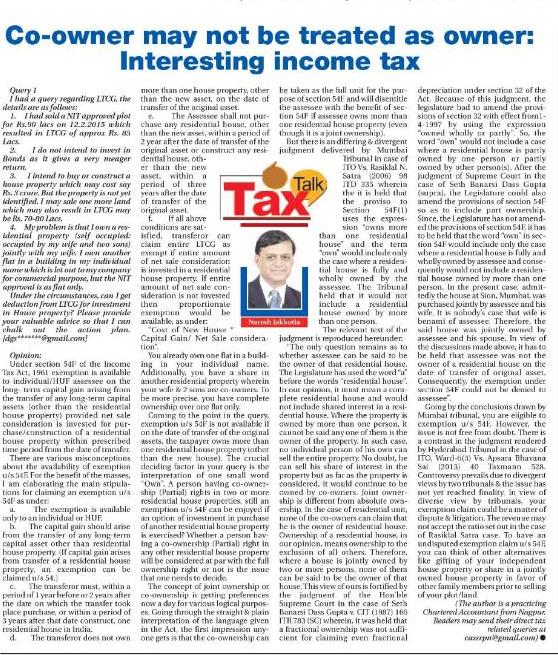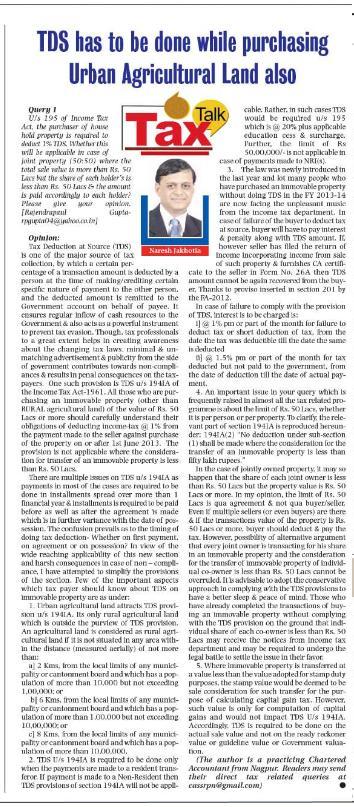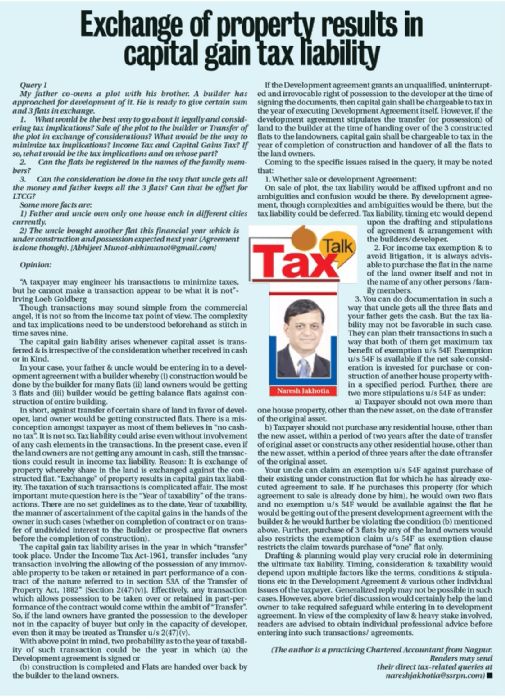FINAL
TAX TALK-17.04.2017-THE HITAVADA
TAX TALK
CA. NARESH JAKHOTIA
Chartered Accountant
Tax issues in Joint Development agreement signed before 01/04/2017
The recent proposal in the Finance Bill-2017 has provided clarity on taxation of Joint Development Agreement (JDA). An amendment would ease the tax burden on the property owner signing JDA.
Query 1]
I had a plot which I gave it to a builder in Joint Venture. Now the builder would construct 4 storied building consisting of 8 flats, wherein builder would keep 5 flats and I would get 3 flats. I would get 1 flat on 1st floor and 2 flats on 4th floor. I want to retain both flats of fourth floor and use it as one residential property as I have a large family whereas I want to dispose off by selling the 1st floor flat. Land Value as per ready beckoner value the land is around 1 crore. I believe, in Joint venture, since half of the flats on land would be with builder, capital gain would be for me on Rs. 50 lakhs. Value of 1 flat as per RR rate is also 50 lakhs and since I will be converting 2 flats as one, value of flats would be 1 crore.
My question is, since the agreement happened on September 2016, should I while filing IT returns mention that against this capital gain I have reinvested the amount in this flat? What proof having the flat on my name do I need to submit to IT Department? What happens when I sell off my 1st floor flat? How would tax be calculated on it? Lastly, I already have an ancestral flat on my name where I am currently living; can I still take benefit of Section 54? [anmolmathur83@gmail.com]
Opinion:
- A new simplified taxation provision [section 45(5A)] for levy of income tax on Joint Development agreements (JDA) is incorporated in the Income Tax Act-1961. However, the new provision would be applicable only on the JDA signed on or after 01.04.2017. Your JDA is signed in September-2016 & so it would be governed by the old taxing provision wherein drafting & words would play vital role in determining the tax implications. The tax treatment would vary from case to case depending upon the clauses incorporated in the JDA & is subject to controversy & litigation.
- Under the earlier regime for taxation of JDA, capital gain liability arises whenever capital asset is transferred & is not at all dependent on the receipt of consideration. Simply, the capital gain tax liability arises in the year in which “transfer” took place. Under the Income Tax Act-1961, transfer includes “any transaction involving the allowing of the possession of any immovable property to be taken or retained in part performance of a contract of the nature referred to in section 53A of the Transfer of Property Act, 1882” [Section 2(47)(v)]. Effectively, any transaction which allows possession to be taken over or retained in part-performance of the contract would come within the ambit of “Transfer”. In your case, it appears that you have given absolute possession of the property to the builder for development & hence capital gain tax liability would trigger in the FY 2016-17. You would be required to incorporate the same in the ITR for the FY 2016-17.
- Exemption u/s 54 is available if the capital gain arises from transfer of a residential house property whereas exemption is available u/s 54F is capital gain arises from transfer of any other capital assets (other than residential house property). In your case, you have transferred the plot (& not residential house property). Hence, you can claim an exemption u/s 54F and not u/s 54 as mentioned in the query. Taxpayers needs to distinguish exemption claim u/s 54 vis a a vis u/s 54F for the following reasons:
a] For exemption u/s 54, investment of Long Term Capital Gain (LTCG) is sufficient & it has nothing to do with the amount of sale consideration. To claim an exemption u/s 54F, investment of entire net sale consideration is relevant.
b] U/s 54F, there is a stipulation that the taxpayer should not be owner of more than one house property. No such condition is there u/s 54.
c] U/s 54F, one more rider is there – The taxpayer should not purchase another residential house property within a period of 2 years (3 years for construction) after claiming an exemption u/s 54F. If taxpayer purchases/constructs another residential house property within said period, exemption claimed earlier would be withdrawn in the year of violation.
In your specific case, you own only one ancestral house property & so you can claim an exemption u/s 54F towards reinvestment in “one residential house”. However, your investment in more than one house property (i.e., 3 flats) would not be in accordance with section 54F.
- You can arrange the transactions in such a way that you retain only two flats in the 4th floor & transfer the first floor flat beforehand i.e., before becoming owner of the 1st floor flat. In short, to be in a safe zone, you should opt to transfer the “right over the first floor flat” than transferring the “ownership of the first floor flat”. This is possible if you opt to transfer the property when it is under construction. As a result of this, you we left with only 4th floor flats for your retention. The possibility of treating two flats on the 4th floor as “one house” is possible. The issue was discussed in length in the Tax Talk dated 24/10/2016. You & other readers having similar issues are advised to refer above issue of tax talk which can be retrieved from www.ehitavada.com.
- For exemption of entire amount of LTCG u/s 54F, taxpayer have to invest the entire amount of sale consideration in “one” house property. You are transferring the plot or share in the plot in favor of builder against which you are getting 3 flats. If you go by above mechanism, you would be retaining two flats (to be treated as one house property) and would be transferring right over one flat. As a result, entire net sale consideration will not be invested but only investment of 2/3rd of the sale consideration would be there. As a result, exemption u/s 54F would be restricted to 2/3rd of the LTCG amount.
- An important issue that remains unanswered so far is the amount of “sale consideration” in your case. Sale consideration in your case could be matter of different opinion. It could be higher of the ready reckoner value of the plot (or share of plot) you are giving to the builder or of the value of the flats you are receiving from the builder.
- While filing the income tax return, no document as such is required to be attached with the income tax return form (It is required to be produced if Assessing Officer demands so). You can claim an exemption towards 2/3rd of LTCG by showing investment of sale consideration of 2/3rd amount in exemption column u/s 54F. Balance 1/3rd of LTCG would be taxable in the FY 2016-17. Amount received over and above the 1/3rd amount of sale consideration against sale of rights in the flat at first floor would be taxable as STCG.
Above advice & opinion is based on the basis of information provided in the query & on the basis of certain set of presumptions. Generalized reply may not be possible in such cases. Above discussion would certainly help you and other readers who have entered into JDA to know the tax implications involved, precautions, planning to be undertaken in such cases. However, in view of the complexity of law & heavy stake involved, readers are advised to obtain individual professional advice before filing their income tax returns.
[Recent amendment for taxation of JDA was covered in the Tax Talk dated 20/03/2017. Readers can retrieve the it from www.ehitavada.com]
[The author is a practicing Chartered Accountant from Nagpur. Readers may send their direct tax related queries at
SSRPN & Co
10, Laxmi Vyankatesh Apartment
C.A. Road, Telephone Exch. Square
Nagpur-440008
or email it at nareshjakhotia@ssrpn.com]
|





.png)




